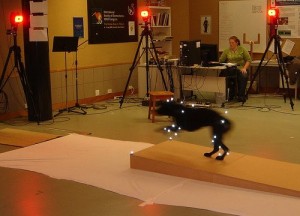Motion capture systems
Currently existing computing systems built for computer graphics are not yet able to create spectacular episodes for humans and animals, as quickly and as cheaply as a professional actor. This applies to both body and facial movements. There are systems which use a combination of the game captured the actor (body or face) and the graphical objects created with the professional computer graphics systems.
Motion capture systems are used for quick data capture motion of living creatures and transforming them into a 3D. They are used in many fields – from 3D games through films and developed websites for medical applications.
Passive optical systems
A significant part of the motion capture systems are passive optical systems. Passive optical system use markers coated with a retroreflective material to reflect light that is generated near the cameras lens. The camera’s threshold can be adjusted so only the bright reflective markers will be sampled, ignoring skin and fabric. Examples of passive optical systems: Ariel, Vicon, Peak Performance, Expert Vision.
Example of a studio using the system optically passive Vicon you can see on the video below.
Active optical systems
Active optical systems triangulate positions by illuminating one LED or multiple LEDs with software to identify them by their relative positions, somewhat akin to celestial navigation. Rather than reflecting light back, the markers themselves are powered to emit their own light.
Examples of active optical systems are Selspot, Watsmart and Optitrak.
System MoCap in Avatar
System features:
- built to order according to concept Cameron
- camera Fusion3D ,
- imposition of a virtual image of the actual in real mode, which implies a preview of the final image on the film and the possibility of repetition of the scenes or shots,
- virtual camera,
- surprisingly a lot of things made in reality-type helicopters, clothes, trees, etc.
- in the production was employed about 1,000 people,
- estimated cost of film $ 280 – $ 310 million (production) and $ 150 million for promotion.
[FILM AVATAR numer 2]
albo
Systemy MoCap dla ruchu zwierząt
Much more difficult situation in the MoCap systems is in the case of animals which are difficult to force them to behave according to the will of the director. Progress is being made in this field. There are various websites from which you can download for free or buy for a relatively small amount different models of animal movement, such as a horse at the trot, gallop, etc. It seems that there are two ways to solve this problem:
- building control systems of the animal brain (e.g. electrodes). Currently, such research are conducted in many centers, such as the military,
- building systems for automatic analysis and synthesis of bone and musculoskeletal system, which analyzing the movements of the animal will produce the equivalent model in the sense of movement. However, this requires more knowledge about the anatomy and movement of animals and probably need much more processing power than those which we currently have.
Right now there is a need to create a „new animals”, such as for the film industry (in the movie Avatar – prolemur or Toruk, etc.)
Let’s see what software is available in the market for modern computer graphics and motion capture. As it seems, is dominated by packets associated with Softimage: FaceRobot and MotionBuilder.
More about these programs you can read in the section Examples of tools.
Summary
Most motion capture systems are based on markers that emit or reflect light. With MoCap systems we can create a realistic moving human figures and animals.
Parent page: Motion capture systems





